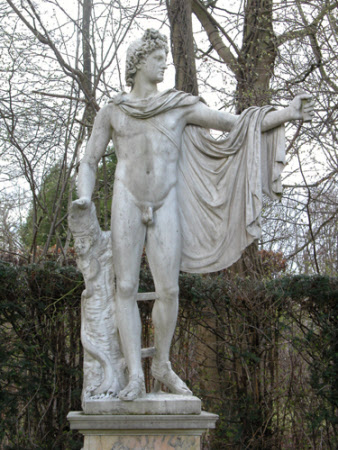Apollo Belvedere
Francis Harwood (1726/7-1783)
Category
Art / Sculpture
Date
1765 (signed and dated)
Materials
Marble
Measurements
2970 x 1300 x 850 mm
Place of origin
Italy
Order this imageCollection
Anglesey Abbey, Cambridgeshire
NT 516654
Summary
Marble, Apollo Belvedere, Francis Harwood (1726-7-1783) after the antique, 1765, signed 'F. Harwood/Fecit 1765' on base. A replica by Francis Harwood of the Apollo Belvedere in the Vatican Museums, Rome. Apollo, in contrapposto, is depicted as a standing archer, his proper left arm extended having just shot an arrow (the bow, once held in the proper left hand, is lost in the original). The figure is nude save for sandals and a chlamys clasped with a fibula over his proper right shoulder and draped over his proper left arm. A quiver, slung across his proper right shoulder, hangs behind his back. The proper right hand is missing, as in the original. A snake slithers up the tree stump at proper right, possibly in reference to the serpent Python slain by Apollo at Delphi. Mounted on a Siena marble-veneered square pedestal, with white marble panels and mouldings, and granite base.
Full description
The original marble, regarded as the model of masculine grace in the 18th century, was first recorded in the garden of Cardinal Giuliano della Rovere, who, as Pope Julius II, had it transferred to the Vatican by 1509. By 1511 it was moved to the sculpture court of the Belvedere and has remained there, with one interruption when it was looted by Napoleon, ever since. The sculpture is thought to be a Hadrianic (130-140 AD) copy of a lost bronze statue by Leochares, one of the artists who worked on the Mausoleum at Halicarnassus. See Haskell and Penny 1981, no. 8 for a full historical account. Francis Harwood lived and worked in Florence for most of his professional life and specialised in high-quality copies of antique sculptures. Harwood was first recorded in Rome in 1752, living with the painter Joshua Reynolds and the sculptor Simon Vierpyl. He trained at the Florentine Academy from1755, gaining notable public commissions which brought him prominence amongst British Grand Tourists in Italy. Notable clients include the 7th Earl of Northampton (1737-63) of Castle Ashby and Robert Adam, who commissioned a copy of the Uffizi Apollo for Syon House. Several of the Northampton commissions were replicated for Sir Lawrence Dundas (c. 1710-81) of Moor Park and the 4th Duke of Gordon (1743-1827) of Gordon Castle, Morayshire. This replica of the Apollo Belvedere is one of at least six recorded statues and busts after the antique produced for Gordon, the others are: a statue of the Marine Venus (1765; sold Bert Crowther of Syon Lodge, 1950, untraced), a bust of Marcus Aurelius (1762; untraced), busts of Seneca and Homer (1763, inv.no. A.26-1948 and 1764, inv.no. A.8-1958, Victoria & Albert Museum, London; both busts given to the V&A by Bert Crowther in 1948) and a bust of a Vestal Virgin (1765; sold Crowther 1950, untraced). Gordon Castle was transferred to the Crown Estate in 1938 and in the early 1950s it was sold and partly demolished. Bert Crowther, then a leading dealer in statuary and architectural salvage, appears to have purchased the Harwood sculptures en masse. He sold the Apollo Belvedere to Lord Fairhaven, a regular client, on 14 March 1950 for the sum of £60. Alice Rylance-Watson 2019
Provenance
Purchased by Alexander Gordon, 4th Duke of Gordon (1743-1827) of Gordon Castle, Morayshire, and thence by descent; sold by The Crown Estate c. 1948-50; purchased by Bert Crowther of Syon Lodge; sold by Bert Crowther to Huttleston Rogers Broughton, 1st Lord Fairhaven (1896-1966) on 14 March 1950, for £60.0.0; bequeathed to the National Trust by Lord Fairhaven in 1966 with the house and the rest of the contents.
Credit line
Anglesey Abbey, The Fairhaven Collection (The National Trust)
Marks and inscriptions
Back of base: F. Harwood/Fecit 1765
Makers and roles
Francis Harwood (1726/7-1783), sculptor
References
Haskell and Penny 1981: Francis Haskell and Nicholas Penny, Taste and the Antique, The Lure of Classical Sculpture 1500 - 1900, New Haven and London, 1981, pp. 148-51, no 8, fig. 77. Fleming and Honour 1968: John Fleming and Hugh Honour, ‘An English Sculptor in XVIII Century Florence’, Festschrift Ulrich Middeldorf, Berlin 1968, pp 510-16. Belsey 1980: Hugh Belsey, ‘A Newly Discovered Work by Francesco Harwood’, Burlington Magazine, vol. 122, no. 922 (Jan 1980), pp 65-66. Bilbey and Trusted 2002: Diane Bilbey and Marjorie Trusted, British Sculpture 1470 to 2000, A Concise Catalogue of the Collection at the Victoria and Albert Museum, London 2002, pp. 88-9. Roscoe 2009: I. Roscoe, E. Hardy and M. G. Sullivan, A Biographical Dictionary of Sculptors in Britain 1660-1851, New Haven and Yale 2009, pp. 583-585.

